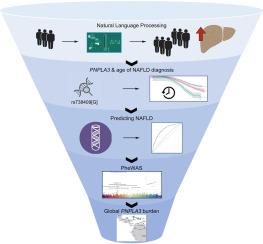当前位置:
X-MOL 学术
›
J. Hepatol.
›
论文详情
Our official English website, www.x-mol.net, welcomes your
feedback! (Note: you will need to create a separate account there.)
A common variant in PNPLA3 is associated with age at diagnosis of NAFLD in patients from a multi-ethnic biobank
Journal of Hepatology ( IF 26.8 ) Pub Date : 2020-06-01 , DOI: 10.1016/j.jhep.2020.01.029 Ryan W Walker 1 , Gillian M Belbin 2 , Elena P Sorokin 3 , Tielman Van Vleck 4 , Genevieve L Wojcik 3 , Arden Moscati 2 , Christopher R Gignoux 5 , Judy Cho 6 , Noura S Abul-Husn 7 , Girish Nadkarni 4 , Eimear E Kenny 7 , Ruth J F Loos 8
Journal of Hepatology ( IF 26.8 ) Pub Date : 2020-06-01 , DOI: 10.1016/j.jhep.2020.01.029 Ryan W Walker 1 , Gillian M Belbin 2 , Elena P Sorokin 3 , Tielman Van Vleck 4 , Genevieve L Wojcik 3 , Arden Moscati 2 , Christopher R Gignoux 5 , Judy Cho 6 , Noura S Abul-Husn 7 , Girish Nadkarni 4 , Eimear E Kenny 7 , Ruth J F Loos 8
Affiliation

|
BACKGROUND
/Aims: Nonalcoholic fatty liver disease (NAFLD) impacts ∼100 million people in the US and is a growing global health concern often remaining undiagnosed. The Ile138Met variant (rs738409) in the PNPLA3 gene shows the largest effect on NAFLD and elevates risk of progression to severe forms of liver disease. It remains unknown if the variant plays a role in age of NAFLD onset. We aimed to use longitudinal Electronic Health Records (EHR), sequencing data and Natural Language Processing (NLP) to determine if the PNPLA3 risk variant impacts NAFLD diagnosis age in >27,000 individuals from a multi-ethnic biobank. METHODS AND RESULTS
Using a novel NLP algorithm applied to EHR data, we defined NAFLD cases (n=1,703) and controls with no evidence of NAFLD on liver imaging (n=8,119). Survival analyses indicated that the PNPLA3 G risk allele was associated with earlier age of NAFLD diagnosis, with the strongest effect in Hispanics (HR=1.33 [1.15-1.53], p<0.0001) among whom a NAFLD diagnosis was 15% more likely in risk allele carriers vs. non-carriers. Prediction analyses showed the PNPLA3 risk allele increased NAFLD risk (OR 1.61 95%CI [1.349-1.73]; p<0.0001), with a strongest effect among Hispanics (OR 1.43 [1.28-1.59], p<0.0001). A Phenome-Wide Association Study (PheWAS) showed the PNPLA3 risk allele was associated with additional liver diseases (p < 4.95 x 10-6) in which the PNPLA3 risk variant associated with earlier age of diagnosis. CONCLUSION
Given the role of the PNPLA3 risk variant in NAFLD diagnosis age, our results suggest that stratifying risk within populations known to have an enhanced risk for liver disease, such as Hispanic carriers of the rs738409 variant, would be effective in earlier identification of those who would benefit most from early NAFLD prevention and treatment strategies.
中文翻译:

PNPLA3 中的一个常见变异与来自多民族生物库的患者诊断为 NAFLD 时的年龄相关
背景/目的:非酒精性脂肪性肝病 (NAFLD) 在美国影响约 1 亿人,并且是一个日益严重的全球健康问题,但往往未被确诊。PNPLA3 基因中的 Ile138Met 变体 (rs738409) 对 NAFLD 的影响最大,并增加了进展为严重肝病的风险。该变异是否在 NAFLD 发病年龄中起作用仍然未知。我们旨在使用纵向电子健康记录 (EHR)、测序数据和自然语言处理 (NLP) 来确定 PNPLA3 风险变异是否影响来自多民族生物库的 27,000 多人的 NAFLD 诊断年龄。方法和结果 使用应用于 EHR 数据的新型 NLP 算法,我们定义了 NAFLD 病例(n=1,703)和在肝脏成像上没有 NAFLD 证据的对照(n=8,119)。生存分析表明,PNPLA3 G 风险等位基因与 NAFLD 诊断的较早年龄相关,在西班牙裔中影响最强(HR=1.33 [1.15-1.53],p<0.0001),其中 NAFLD 诊断的风险高 15%等位基因携带者与非携带者。预测分析显示 PNPLA3 风险等位基因增加了 NAFLD 风险(OR 1.61 95%CI [1.349-1.73];p<0.0001),在西班牙裔中影响最强(OR 1.43 [1.28-1.59],p<0.0001)。一项全表型关联研究 (PheWAS) 显示 PNPLA3 风险等位基因与其他肝脏疾病相关 (p < 4.95 x 10-6),其中 PNPLA3 风险变异与较早的诊断年龄相关。结论 鉴于 PNPLA3 风险变异在 NAFLD 诊断年龄中的作用,
更新日期:2020-06-01
中文翻译:

PNPLA3 中的一个常见变异与来自多民族生物库的患者诊断为 NAFLD 时的年龄相关
背景/目的:非酒精性脂肪性肝病 (NAFLD) 在美国影响约 1 亿人,并且是一个日益严重的全球健康问题,但往往未被确诊。PNPLA3 基因中的 Ile138Met 变体 (rs738409) 对 NAFLD 的影响最大,并增加了进展为严重肝病的风险。该变异是否在 NAFLD 发病年龄中起作用仍然未知。我们旨在使用纵向电子健康记录 (EHR)、测序数据和自然语言处理 (NLP) 来确定 PNPLA3 风险变异是否影响来自多民族生物库的 27,000 多人的 NAFLD 诊断年龄。方法和结果 使用应用于 EHR 数据的新型 NLP 算法,我们定义了 NAFLD 病例(n=1,703)和在肝脏成像上没有 NAFLD 证据的对照(n=8,119)。生存分析表明,PNPLA3 G 风险等位基因与 NAFLD 诊断的较早年龄相关,在西班牙裔中影响最强(HR=1.33 [1.15-1.53],p<0.0001),其中 NAFLD 诊断的风险高 15%等位基因携带者与非携带者。预测分析显示 PNPLA3 风险等位基因增加了 NAFLD 风险(OR 1.61 95%CI [1.349-1.73];p<0.0001),在西班牙裔中影响最强(OR 1.43 [1.28-1.59],p<0.0001)。一项全表型关联研究 (PheWAS) 显示 PNPLA3 风险等位基因与其他肝脏疾病相关 (p < 4.95 x 10-6),其中 PNPLA3 风险变异与较早的诊断年龄相关。结论 鉴于 PNPLA3 风险变异在 NAFLD 诊断年龄中的作用,











































 京公网安备 11010802027423号
京公网安备 11010802027423号